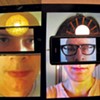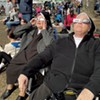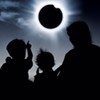Published June 20, 2011 at 11:33 a.m.
I've heard a lot lately about augmented reality, one of those brave-new-world-type tech trends people talk about at web conferences. It's basically the ability to create an altered version of reality that's accessible to anyone looking through the lens of a smartphone.
I had my first experience with it on Saturday. I expected that to happen in a big city, maybe Boston or New York. I never would have guessed that I'd encounter my first augmented-reality objects on a walking tour in Woodstock, Vt.
New-media artist and Pace University professor Will Pappenheimer led the tour. That morning, Pappenheimer had placed virtual, 3D, animated objects in various spots around town. At the start of the afternoon excursion, he asked the eight of us who joined him to load the Layars app onto our smartphones. Then he led us to the installation sites, instructed us to turn on our video cameras, and told us where to look.
At each site, we saw an object that seemed to be just part of the scenery. The image above, of the blue flowery thing floating inside the covered bridge, is not Photoshopped — it's a screenshot from 7D deputy web editor Tyler Machado's iPhone.
The tour was part of the inaugural Woodstock Digital Media Festival, an event that aimed to showcase "the most interesting, progressive and accessible work in the world of digital media today." Organizer David McGowan, a media executive who splits his time between Woodstock and London, hopes the festival will become an annual occurrence.
I hope so, too. I was there to moderate a panel discussion on "Digital Vermont." I was initially a little skeptical about the digital art, but every time I would start to head to the car to drive home, something else would pull me back in.
Such as the augmented reality tour. That was the highlight of the day for me. Here's a photo our our tour group clustered on the covered bridge, staring into our phones at the object floating above the lane of traffic. The contrast between our surroundings and our reason for being there made me smile.
Pappenheimer calls his artworks "WiWo Spinners," after "Wireless Woodstock", the community's Wi-Fi network. They have individual titles, too, though I didn't catch them all. The first spinner we saw was a constellation of peach-colored particles hovering above a house in town. Pappenheimer referred to it as "Anthony Weiner's exploded upper torso."
A swirling bunch of blue bits near the town green represented "the exploding Google logo" (below). We had to walk out into the road near the town green to see that one.
I was looking at it on Pappenheimer's phone, which he had mounted inside a three-sided black-box viewer that made the screen visible on a sunny day. When he pointed it over the intersection, I could see this cloud of blue panels swirling all around us. I felt like they were raining down on me. The people in the cars driving through the shrapnel had no idea they were moving through an art installation. They probably also wondered what the hell we were doing in the middle of the road.
I know this all sounds a little absurd. But as Pappenheimer informed us on our stroll, digital artists aren't the only ones playing in this space. Businesses and marketers are there, too. If he can plant these odd objects all over town, then someone can embed ads there. No one "owns" this space, and there are no rules governing it. With the right coordinates, someone could embed an object inside your house.
And, unlike the art in a typical exhibit, these "spinners" Pappenheimer has made aren't coming down at the close of the show. He's not planning to remove them, so they'll be floating there in Woodstock forever, or until all of our fancy technology fails us. If you've got a video-enabled smartphone, you can see them, too.
There were several other artists who traveled from more urban environs for the festival. Here's an interview with two of the arts organizers from the blog Art Fag City. I missed the morning panel with Christiane Paul, curator of new media at the Whitney Museum of American Art. But I got to try C.J. Yeh's interactive "MyData=MyMondrian" exhibit, which invited gallery goers to share personal data (height, weight, eye color, age, hobbies, income) at a computer station. The computer used an algorithm to translate the data into a personalized, Mondrian-style grid. Sadly, mine wasn't that colorful or exciting. Alas.
Yeh also displayed three ghostly digital images that looked misaligned somehow. A pile of papers sat on the table in front of them, printouts of the digital code that created each image. A magnifying glass sat on top of the pile. When you looked through it, you could see that the phrase "CJ was here" had been inserted, apparently randomly, throughout the document.
Yeh was on hand to answer questions. He explained that he had replaced all of the "@" symbols with his tag. The beautiful but oddly flawed photos were the result of his tinkering.
Tyler and I also talked with Jack Toolin, who was sitting in front of the library behind a cardboard sign that advertised him as the "Village Idiot." His contribution to the festival was some kind of data-driven performance art I didn't quite understand. He told us he knew nothing about Woodstock and was trying to learn about it from the people who passed by his booth.
I happily filled out the survey he gave me, which tested my knowledge of the village with questions about the size of the population and my favorite intersection. My answers were totally meaningless, because it was my first time there. He insisted it didn't matter. He recorded me pronouncing "Ottauquechee," and said he was going to use it during a presentation at the evening gathering. I missed it, though. Tyler and I headed home after the augmented-reality tour.
I wish we'd been able to stay. The day raised a lot of questions and I would have liked the chance to talk more with other participants. Maybe next year...
Update, 6/21/11:
Taylor Dobbs of Vermont Digger posted an article yesterday describing the seemingly oxymoronic Digital Nature Walk, another of the activities at Saturday's festival. Dobbs chats with Project Noah founder Yasser Ansari, who explains how his app helps people connect with nature.
Will Pappenheimer has posted additional photos of his WiWo Spinners on his website.
One or more images has been removed from this article. For further information, contact
[email protected].
More By This Author
Speaking of Blurt
-
Blurt Is No More. Here's Where to Find New Seven Days Content
Sep 17, 2012 -
Alice Eats: The Mill Market & Deli
Sep 11, 2012 -
Grazing at King Arthur Flour's Airy New Digs
Sep 10, 2012 -
Movies You Missed 55: Making Plans for Léna
Sep 7, 2012 -
Quiz: Ben & Jerry's Flavor or Porn Flick?
Sep 6, 2012 - More »
Comments (3)
Showing 1-3 of 3
Comments are closed.
From 2014-2020, Seven Days allowed readers to comment on all stories posted on our website. While we've appreciated the suggestions and insights, right now Seven Days is prioritizing our core mission — producing high-quality, responsible local journalism — over moderating online debates between readers.
To criticize, correct or praise our reporting, please send us a letter to the editor or send us a tip. We’ll check it out and report the results.
Online comments may return when we have better tech tools for managing them. Thanks for reading.















































